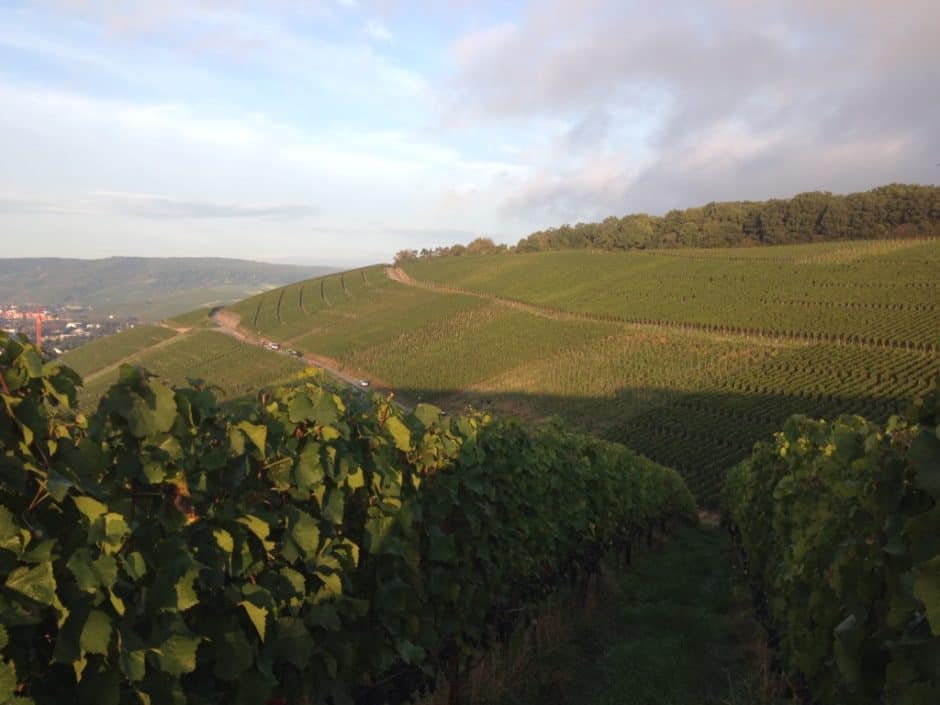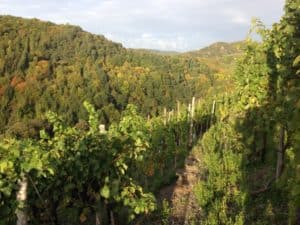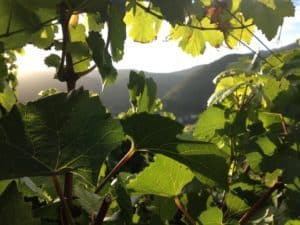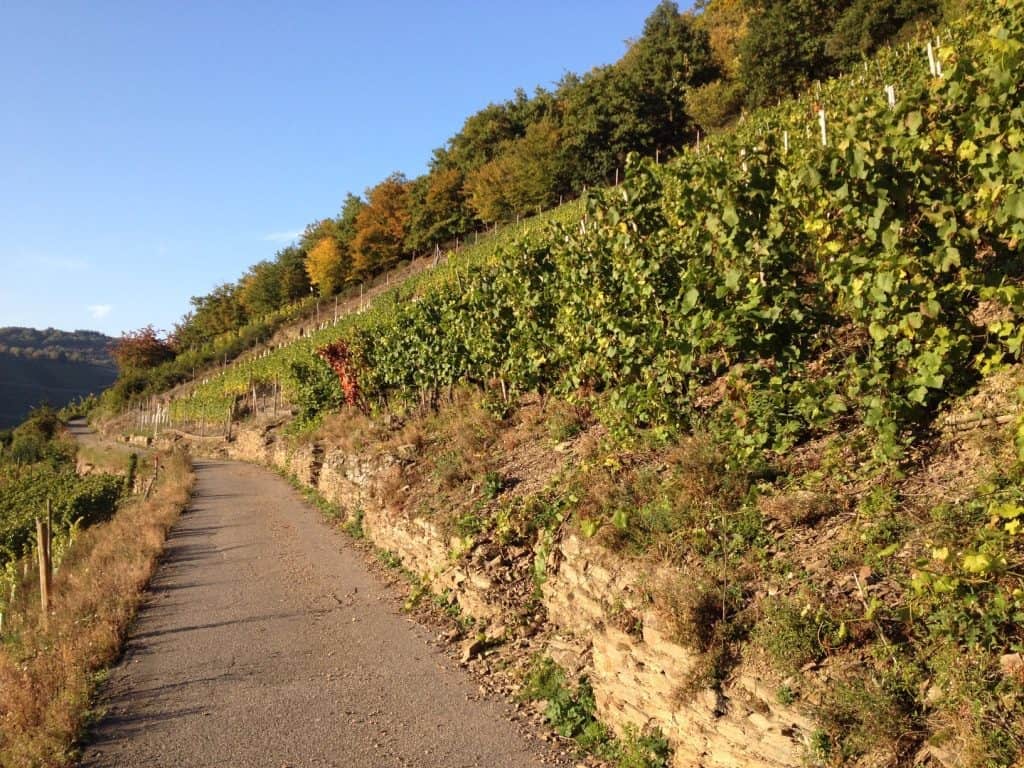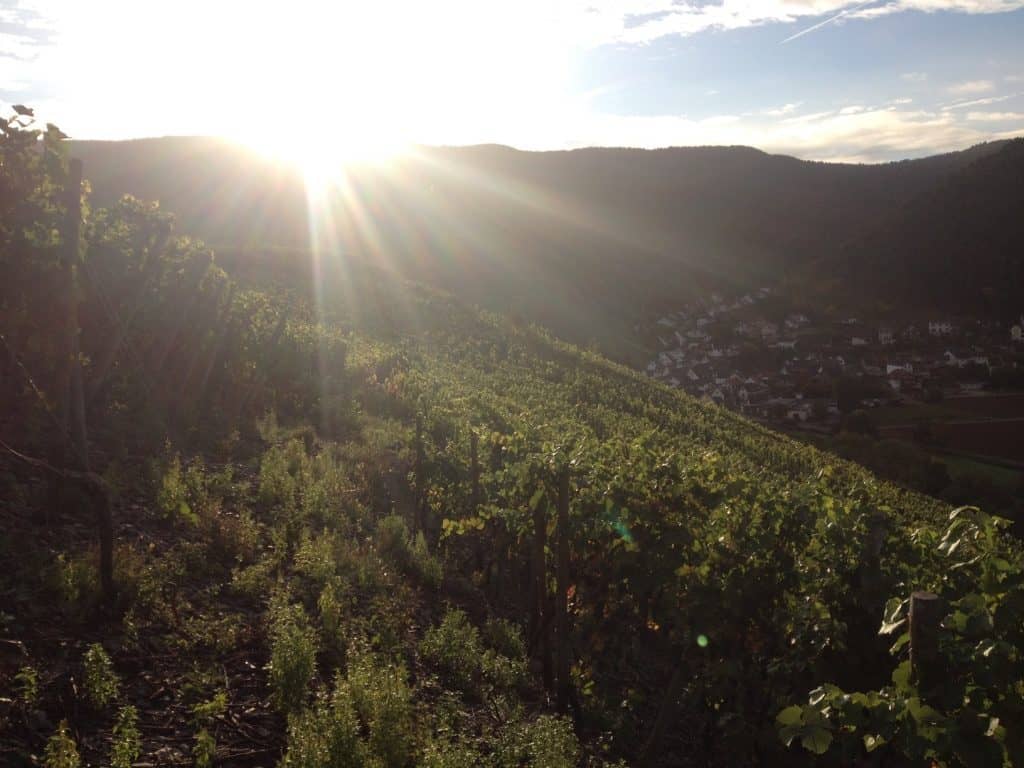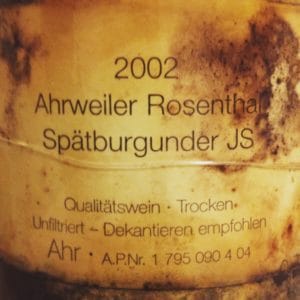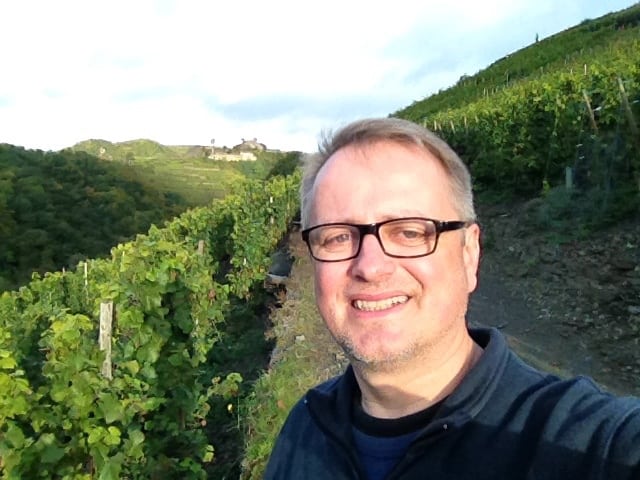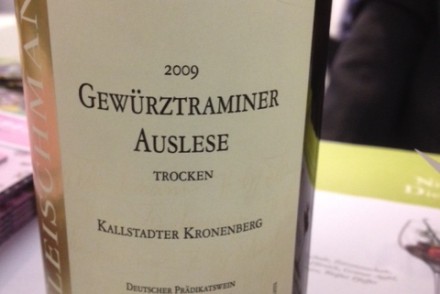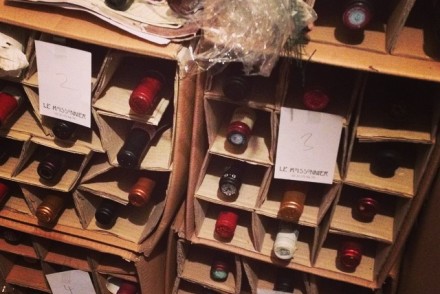Last day of Ahr Valley harvest, 15th October 2015…
Today is Day 9 of my harvest experience in the Ahr Valley at Jean Stodden winery in Rech.
The Ahr Valley is one of Germany’s most northern wine-growing regions, famous for its Spätburgunder (aka Pinot Noir).
Yesterday we finished hand harvesting the Spätburgunder. Today only the Riesling is left.
“Not too much,” our Supervisor says. “Approximately 0.5 hectares. The local harvesting crew is coming too.”
“No worries – half a day and it will be done”, I think to myself.
The Riesling vines are located on seven different plots and on some of the most challenging terrain I have ever experienced. If you are familiar with the Mosel vineyard sites you’ll get the picture: small vineyard plots planted on gravely rock and slate, situated on steep slopes. Quite often it is impossible to get into these plots with machine harvesters.
Hand harvesting is often the only way to get the grapes off the vines. It is a time-consuming, labour intensive, and a costly exercise.
The Ahr Valley is very similar, just smaller.
The landscape is dramatically beautiful, created over 40 million years ago by volcanic activity, an assembly of smaller and larger hills dotted with the odd volcano crater. The last recent major volcanic activity was “only” 10,000 years ago, and the region still experiences the occasional tremor.
Over the past two million years the River Ahr has paved its way through the hills and now forms this valley. The south-facing hillsides provide some of the best locations in Germany for Spätburgunder. The southerly aspect of the vineyards – which provide as much sunlight as possible to the vines, also combined with the gravely slaty soil – are vital for successful ripening of the vines and grapes.
The soil is rich in minerals and the slate has the ability to store the warmth of the sunlight, which it returns slowly to the vines overnight. All of this contributes to a long and even ripening period.
But I digress: here am I, trying to feel positive about this last day of harvest, despite the weather conditions. It’s cold: the rain gets through every layer of my clothing, and my shoes too.
“Stop whinging and feel sorry for yourself!” I tell myself. “Focus on the job ahead of you, and get the work done!”
“Look at your picking crew comrades. Many of them are in their late-60s – are they complaining? Some of them even harvest faster than you do!”
So I start to pick the Riesling grapes, some of them infected by Botrytis, or “Noble Rot”. First I was a little disappointed at seeing the Botrytis, as the Ahr Rieslings are not known for Botrytis-affected wine styles. However the vineyard supervisor explains to me that a percentage of grapes infected by Noble Rot are quite welcome as they eventually add more aromas and complexity to the finished wine.
I try some of the Noble Rot-infected berries and immediately detect some of the aromas he’s referring to; nuttiness, honeysuckle, and an overall more concentrated fruit taste.
I continue harvesting. It’s getting closer to lunchtime. By now most of us don’t feel like having a break anymore. The thought of sitting inside the warm staffroom at the winery is tempting but the additional thought of getting out again after lunch in our wet clothes, back into the cold and miserable weather, is less appealing.
We decide to soldier on. After walking uphill to the next vineyard we’re met by Mrs. Stodden who kindly supplies us with hot beverages and chocolate out of the boot of her car. We need it! After a short break we jump back into it. The little refreshment gives us an energy boost and we go back to harvesting with a refreshed spirit.
I enjoy looking at these vines – most of them are very old. And to my surprise some of them are even ungrafted – on their own roots – not on American rootstock.
How is this possible after Phylloxera?
Phylloxera – that dreadful disease which wiped out most of the world’s vineyards towards the end of the 19th century – didn’t make it to this part of the Ahr Valley. As with the few other vineyards around the world that did survive, the reason is in the soil. Many of the surviving vineyards are planted on fine sandy soil – or gravely rock and slate – hostile conditions for the vicious vine louse of Phylloxera.
After the planting of new vineyards commenced in the early 20th century, it became common practice to graft the European Vitis Vinifera vines onto American rootstock, proven to be resistant to the vine louse. But not these oldies! They still had their own roots. Wow!
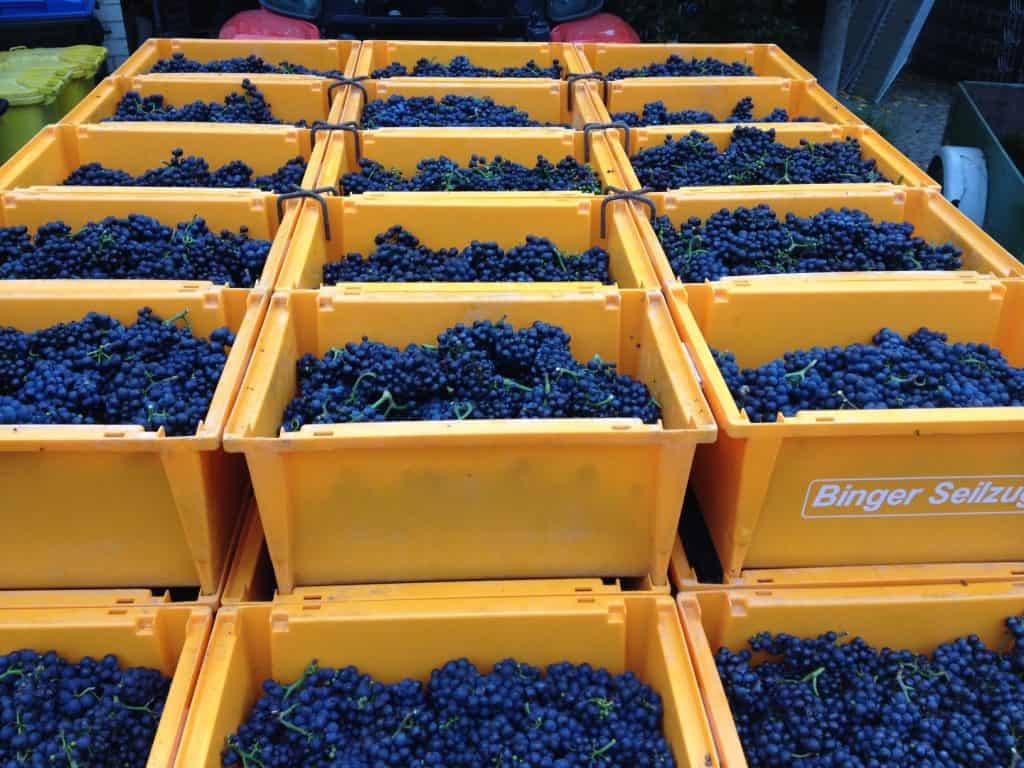
Pinot Noir grapes harvested from the Premier Cru location, Jean Stodden ‘Herrenberg’ vineyard. Photo: Oliver Budack (c) 2015
But back to harvest: these vines are pruned and trellised in the ‘Cordon Vertigo’ fashion, a technique that was applied by the Ancient Greeks and Romans. The vines are on single stakes and the “cordon” (old wood) grows vertically instead of horizontally. And despite their age these vines are carrying quite a lot of fruit – and delicious fruit at that!
The issue when you hand harvest with this system is that the fruit zone is quite high, starting at approximately two meters.
So reaching that high with your arms towards the sky ensures that the rain will also run down into your armpits and from there, downwards… It didn’t matter anymore though – we are cold and wet, but know that there are only one or two vineyards left to go!
After finishing the last vineyard the local picking crew is sent back to the winery to enjoy a hot meal. I too am looking forward to enjoying some of Mrs. Stodden’s finest cooking! But first I want to go home to get changed, knowing we have at least another couple of hours ahead of us, de-stemming the grapes and pressing the must. Then, cleaning up.
My hopes are getting high: I can see the ‘light at the end of the vineyard’. “Not before we finish the last vineyard”, the boss Alexander Stodden says to me.
“I thought this was it?” I reply. Nope!
“Don’t worry about it, get in the car and just do it!” I say to myself, sternly.
There are only five of us left: myself, the two vineyard supervisors and two of the winery’s longest-serving team members. Suddenly I feel quite exhilarated and emotional. There I am among the winery’s most accomplished workers, finishing the last vineyard with them for the season!
The last plot is an old terraced vineyard consisting of three levels going up the mountain. I love goats: in my past life perhaps I was one? You definitely need to have some goat-like climbing skills to get up these terraces! I take it easy, climbing up small steps made from slate and inserted into very old retaining walls.
Leaning my body weight against the mountain, trying not to fall off, I carry my grape crates up these steps to the third terrace level.
Harvesting is a breeze now where we are all joking and the work is suddenly so easy. The views are breathtaking. Overlooking the terraced vineyards – where there are old vines and even the ruins of an 800 year-old castle – compensates for this day of hard work.
After not too long my colleagues finish and start descending the hill. I’m the last one left on the mountain: I take the opportunity to one more time drink in the views and then I cut the last Riesling grape of Stodden’s 2015 harvest! I feel like I have just climbed Mount Everest.
We go back to the winery and I go home to shower and change. Once I arrive back my colleagues are already starting to de-stem the grapes and pump the must straight into the press. From there the juice is pumped into fermentation tanks. I am greeted back with some laughter now, as some of my co-workers think I might have fallen asleep at home.
We finish cleaning up and afterwards the boss, Alexander, invites us to celebrate ‘Mateljass’ – the local word for end of harvest celebration. The celebration takes place inside the Cellar Door’s most beautiful barrel room tasting area. The room’s walls are made from ‘Grauwacke’ bricks, similar to the slate in the vineyards.
A large open log fire heats the room, adding to the cosy atmosphere. A selection of the region’s finest Spätburgunders greets us on a large wooden table, amongst them Meyer-Näkel, Kreuzberg, Adeneuer, Deutzerhof and of course the Jean Stodden wines. The selection ranges from 2008 – 2013 with most being Grosse Gewächse (GG), the higest quality level in the Verein Deutscher Prädikatsweingüter (VDP).
We are all very satisfied to be rewarded with tasting these beautiful wines, and to enjoy such a wonderful meal.
The atmosphere is joyful, but humble. Alexander Stodden thanks us for a job well done and expresses his gratitude for the good harvest.
Everyone is happily exhausted – happy to have finished yet another vintage. As I sit in the tired but merry room, I begin to review the last two weeks in my head, thinking about the labour we carried out in the vineyards. And the small yields most family-owned vineyards produce… That at the end of the day wine is an agricultural product – a product of hard work and nature’s mercy.
There is one thing that cheap wine can never have: soul.
Drinking a handmade wine gives you the opportunity to have a much deeper, more personal experience. The whole process of eating and drinking slows down, your taste buds are more engaged and the bottle of wine is suddenly more than just ‘a bottle of wine’ to be mindlessly bought and consumed.
Handmade wine represents passion, poetry and love. And someone’s dedicated livelihood.
That’s what I am grateful to know, and to have taken part in, these past two weeks.
(c) Photos & text Oliver Budack
- View the full Ahr Valley photo album on the Enjoyment Aficianado Facebook page.
- My grateful thanks and appreciation to Alexander Stodden and the team from his vineyard.

